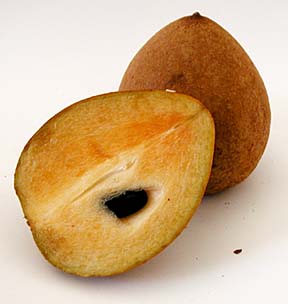

Key Ingredient

|
Walk around Chinatown this week and you'll find an interesting fruit that looks like a small potato. It's called chico, but many may also know it as sapodilla. It's a favorite among Filipinos, but will be somewhat exotic-tasting for those trying it for the first time.The basics: Chico, also called sapodilla or naseberry in Jamaica and the Caribbean, is the fruit of a large tropical evergreen. It is egg-shaped with a fuzzy brown exterior similar to kiwi fruit. Inside are two black seeds surrounded by a slightly granular flesh, which ranges from tan to pinkish-brown and has a sweet taste similar to brown sugar or maple syrup. The flavor is also similar to Fuyu persimmons.
Sapodilla is native to South and Central America and was introduced to the Philippines by the Spanish. The sap of the sapodilla tree was traditionally extracted to make chicle, an early form of chewing gum. Chico is now grown throughout the Philippines, Indonesia, India and the Caribbean and is a good source of potassium and vitamin C.
Selecting: Choose fruit that is smooth and free of dark spots. It should give slightly to pressure. Watch out for shriveled or wrinkled skin or fruit that is too soft -- sure signs that it's overripe.
Storing: Chico can be eaten only when fully ripe. If hard, leave it out for a couple of days until it begins to soften. You can then refrigerate it for a couple of days.
Use: Rinse fruit before consuming. Cut in half diagonally and remove seeds. Spoon out flesh from skin or peel. Chico is generally eaten as is, but the flesh can be blended with a tropical fruit juice for a refreshing drink.
Where to buy: Chico will be available through early spring. Chinatown vendors and some Asian markets catering to Filipinos should have the fruit on hand. Prices range from $1.99 to $2.99 a pound.
Food Stuffs: Morsels
Eleanor Nakama-Mitsunaga is
a free-lance food writer. Contact her
online through features@starbulletin.com